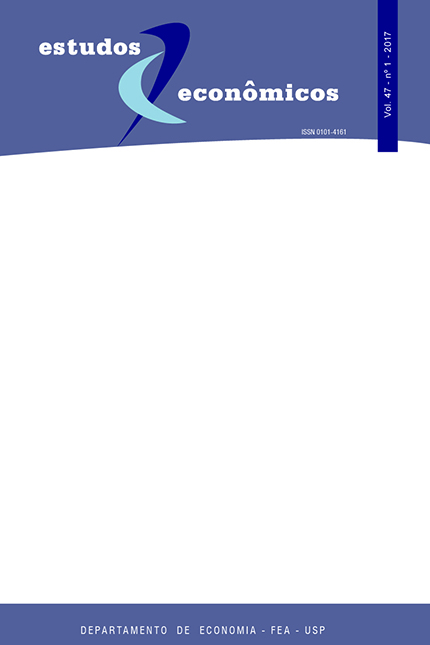Post-2008 Brazilian fiscal policy: an interpretation through the analysis of fiscal multipliers
DOI:
https://doi.org/10.1590/0101-416147149caaKeywords:
DSGE Models, Fiscal Multipliers, New Keynesian ModelAbstract
The global crisis that erupted in 2007 led many countries to embark on countercyclical fiscal policies as a way to cushion the blow of a depressed aggregate demand. Advocates of discretionary measures emphasize that fiscal policy can indeed stimulate the economy. The main goal of this work is to assess whether the fiscal policies pursued by the Brazilian government in the aftermath of the 2008 crisis, succeeded in bringing the economy back on track in a sustainable fashion. To this end, the fiscal multipliers of five different shocks are studied in a small open-economy New Keynesian framework. Our results point to the government spending and public investment as the most effective fiscal tools for combating the crisis. However, the highest fiscal multiplier turned out to be the one associated with excise tax reductions.
Downloads
References
BATINI, N., EYRAUD, Luc and WEBER, A. A Simple Method to Compute Fiscal Multipliers. IMF
Working Paper No. 14/93; June, 2014.
BLANCHARD, O. J. and KAHN, C. M. The Solution of Linear Difference Models under Rational
Expectations. Econometrica, Econometric Society, vol. 48(5), pages 1305-11, July, 1980.
CALVO, G. Staggered Prices in A Utility-Maximizing Framework. Journal of Monetary Economics, 12, p. 383-398, 1983.
CANOVA, F. Methods for Applied Macroeconomic Research. New Jersey: Princeton University Press. 492 p, 2007.
CARVALHO, F. A., and VALLI, M. An estimated DSGE Model with Government Investment an Primary Surplus rule: the Brazilian case. $32^0$. Encontro da SBE, Salvador: SBE, 2010. Available in:
http://bibliotecadigital.fgv.br/ocs/idex.php/sbe/EBE10/paper/view/2141/1061. Accessed on: February 14, 2016.
CASTRO, M. R., GOUVEA, S. N., MINELLA, A., SANTOS, R. and SOUZA-SOUBRINHO, N. F.
SAMBA: Stochastic analytical model with a bayesian approach. Banco Central do Brail. Working Papers Series n. 29, p. 1-138, 2011. In: hhttp://bcb.gov.br/pec/wps/ingl/wps239.pdf. Acesso em: 02 out 2013.
CAVALCANTI, M. A. F. H., and VEREDA, L. Propriedades dinamicas de um modelo DSGE com
parametrizacoes alternativas para o Brasil. Ipea, Texto para Discussão, n 1588, 2010.
CAVALCANTI, M. A. F. H. and SILVA, N. L. C. Dívida pública, política fiscal e nível de atividade: uma abordagem VAR para o Brasil no período 1995-2008. Economia Aplicada, 14(4), 391-418, 2010.
CAVALCANTI, M. A. F. H., and VEREDA, L. (in press). Fiscal Policy Multipliers in a DSGE Model
for Brazil, 2016. Available in: http://bibliotecadigital.fgv.br/ojs/index.php/bre/article/view/57570.
Accessed on: February 14, 2016.
CHRISTIANO, L., EICHENBAUM, M. and REBELO, S. When is the government spending multiplier large? NBER working paper series, working paper 15394, 2009.
DEJONG, D., N., and DAVE, C. Structural Macroeconometrics. New Jersey: Princeton University
Press. 338 p., 2007.
DIXIT, A. K. and STIGLITZ, J. E. Monopolistic competition and optimum product diversity. The
American Economic Review, 67, p. 297-308, 1977.
FANTINATTI, A. M. Estímulos fiscais em um modelo DSGE: bens duráveis versus bens não duráveis. Dissertação de Mestrado Profissional. Fundação Getúlio Vargas - Escola de Economia São Paulo, 2015.
GIAMBIAGI, F. 18 anos de política fiscal no Brasil: 1991/2008. Economia aplicada, 12(4), 535-580, 2008.
GIAMBIAGI, F. A política fiscal do governo Lula em perspectiva histórica: qual é o limite para o aumento do gasto público? Planejamento e políticas públicas, (27), 2009.
ILZETZKI, E., MENDOZA, E.G. and VÉGH, C.A. How big (small?) are fiscal multipliers? Journal of
Monetary Economics, 60, p. 239-254, 2013.
ISKREV, N. Local identification in DSGE models, Journal of Monetary Economics, 57(2), 189–202, 2010.
MENDONÇA, M. J. C., MEDRANO, L. A. and SACHISIDA, A. Avaliando a Condição da Política
Fiscal no Brasil. Revista de Economia e Administração (Impresso), v. 9, p. 294-316, 2010.
MOREIRA, T. B. S. A crise financeira internacional e as políticas anticíclicas no Brasil. 2010. Disponível em: .
MOURA, G. V. Multiplicadores Fiscais e Investimento em Infraestrutura. Rio de Janeiro: Revista
Brasileira de Economia, v. 69, n.1, p. 75-104, 2015.
MUSSOLINI, C. C. Ensaios em política fiscal. Tese de Doutorado (Doutorado em Economia de Empresas) Fundação Getúlio Vargas - Escola de Economia São Paulo, 2011.
PERES, M. A. F. and ELLERY JR., R. G. Efeitos dinâmicos dos choques fiscais do governo central do PIB do Brasil. Pesquisa e Planejamento Econômico, 39(2), 159-206, 2009.
SCHMITT-GROHÉ, S., and URIBE, Martín. Closing small open economy models. Journal of International Economics, 61, pg 163-185, 2003.
SPILIMBERGO, A., SYMANSKY, S. and SCHINDLER, M. Fiscal Multipliers. IMF Staff position
note 2009/11 (Washington: International Monetary Fund), 2009.
STÄHLER, N., and THOMAS, C. FiMod—A DSGE model for fiscal policy simulations. Economic
Modelling, 29(2), 239-261, 2012.
ZUBAIRY, S. On fiscal multipliers: estimates from a medium scale DSGE model. International Economic Review, v. 55, issue 1, p. 169-195, 2014.
WOODFORD, M. Simple analytics of the government expenditure multiplier. American Economic Journal: Macroeconomics, American Economic Association, vol. 3(1), pages 1-35, January, 2010.
Downloads
Published
Issue
Section
License
Copyright (c) 2017 Celso José Costa Junior, Alejandro Caetano Garcia-Cintado, Armando Vaz Sampaio

This work is licensed under a Creative Commons Attribution-NonCommercial 4.0 International License.
By submitting an article, the author authorizes its publication and attests that it has not been submitted to any other journal. The original article is considered final. Articles selected for publication are proofread for grammatical and orthographic errors. The journal does not pay rights for published articles. The Institute of Economic Research from the School of Economics, Business and Accounting of the University of São Paulo (Instituto de Pesquisas Econômicas da Faculdade de Economia, Administração e Contabilidade da Universidade de São Paulo) owns the journal's copyright.




